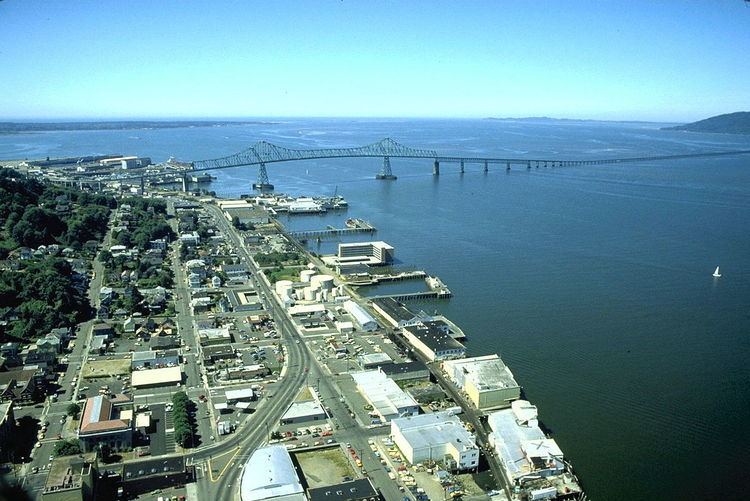ID number s0000548 Construction started 5 November 1962 Clearance below 60 m | Total length 6,545 m Opened 29 July 1966 | |
 | ||
Similar Astoria Column, Columbia River Maritime, Captain George Flavel Ho, Astoria Riverfront Trolley, Oregon Film Museum | ||
The Astoria–Megler Bridge is a steel cantilever through truss bridge that spans the Columbia River between Astoria, Oregon and Point Ellice near Megler, Washington, in the United States. Located 14 miles (23 km) from the mouth of the river, the bridge is 4.1 miles (6.6 km) long and was the last completed segment of U.S. Route 101 between Olympia, Washington, and Los Angeles, California. It is the longest continuous truss bridge in North America.
Contents
History
Ferry service between Astoria and the Washington side of the Columbia River began in 1926. The Oregon Department of Transportation purchased the ferry service in 1946. This ferry service did not operate during inclement weather and the half-hour travel time caused delays. In order to allow faster and more reliable crossings near the mouth of the river, a bridge was planned. The bridge was built jointly by the Oregon Department of Transportation and Washington State Department of Transportation.
Construction on the structure began on November 5, 1962. The concrete piers were cast at Tongue Point, 4 miles (6.4 km) upriver. The steel structure was built in segments at Vancouver, Washington, 90 miles (140 km) upriver, then barged downstream where hydraulic jacks lifted them into place. On August 27, 1966, with more than 30,000 people in attendance, Governors Mark Hatfield of Oregon and Dan Evans of Washington opened the bridge by cutting a ceremonial ribbon. The cost of the project was $24 million, equivalent to $177 million today, and was paid for by tolls that were removed on December 24, 1993, more than two years early.
Details
The bridge is 21,474 feet (6,545 m) in length and carries one lane of traffic in each direction. The cantilever-span section, which is closest to the Oregon side, is 2,468 feet (752 m) long, and its main (central) span measures 1,233 feet (375.8 m). The bridge was built to withstand 150 mph (240 km/h) wind gusts and river water speeds of 9 mph (14 km/h). As of 2004, an average of 7,100 vehicles per day use the Astoria–Megler Bridge. Designed by William Adair Bugge (July 10, 1900 - November 14, 1992), construction of the cantilever truss bridge was completed by the DeLong Corporation, the American Bridge Company, and Pomeroy Gerwick.
The south end is located at 46.18723°N 123.85427°W / 46.18723; -123.85427 (Astoria–Megler Bridge south end) beside what used to be the toll plaza, at the end of a 650-metre (2,130 ft) long inclined ramp which goes through a 360° loop while gaining elevation to clear the channel over land. The north end is at 46.24084°N 123.87493°W / 46.24084; -123.87493 (Astoria–Megler Bridge north end) and connects directly to SR 401. Since most of the northern portion of the bridge is over shallow, non-navigable water, it is low to the water.
Repainting the bridge was planned for May 2009 through 2011 and budgeted at $20,000,000 to be shared by the states of Oregon and Washington. However, a four-year planned paint stripping and repainting project is planned for March 2012 through December 2016.
Pedestrians
Normally, only motor vehicles and bicycles are allowed on the bridge—not pedestrians. However, one day a year, usually in October, the bridge is host to the Great Columbia Crossing. The event uses the 4 miles (6.4 km) long bridge to cross the river. The entire route is 10 kilometres (6.2 mi). Participants are taken by shuttle to the Washington side from where they run or walk to the Oregon side. Motor traffic is allowed to use only one lane (of two lanes) and is advised to expect delays during the two-hour race.
Popular culture
The bridge itself is featured prominently in the movies Short Circuit, Kindergarten Cop, and The Goonies. It stands in for the doomed fictional Madison Bridge in Irwin Allen's 1979 made-for-TV disaster movie The Night the Bridge Fell Down.
